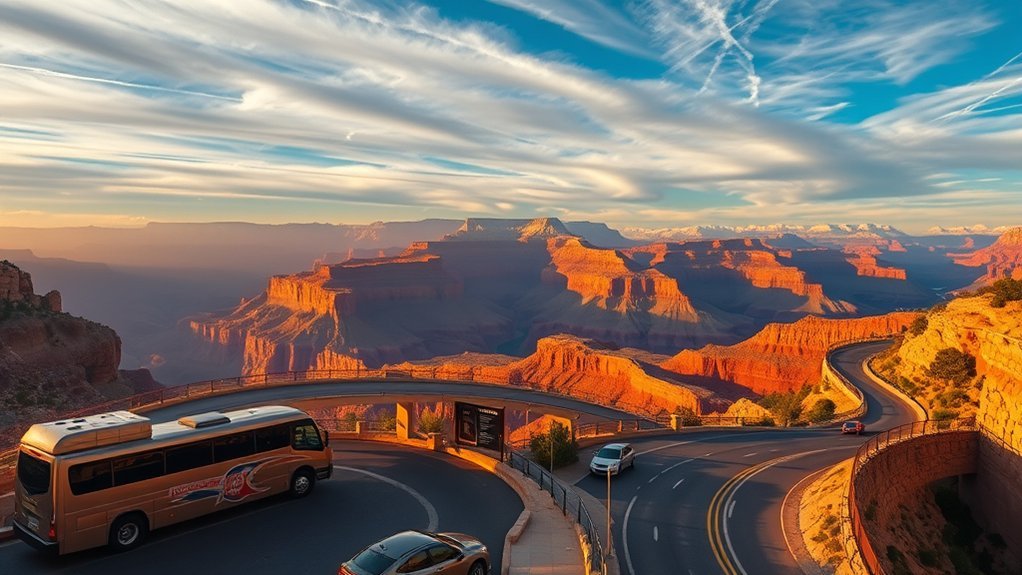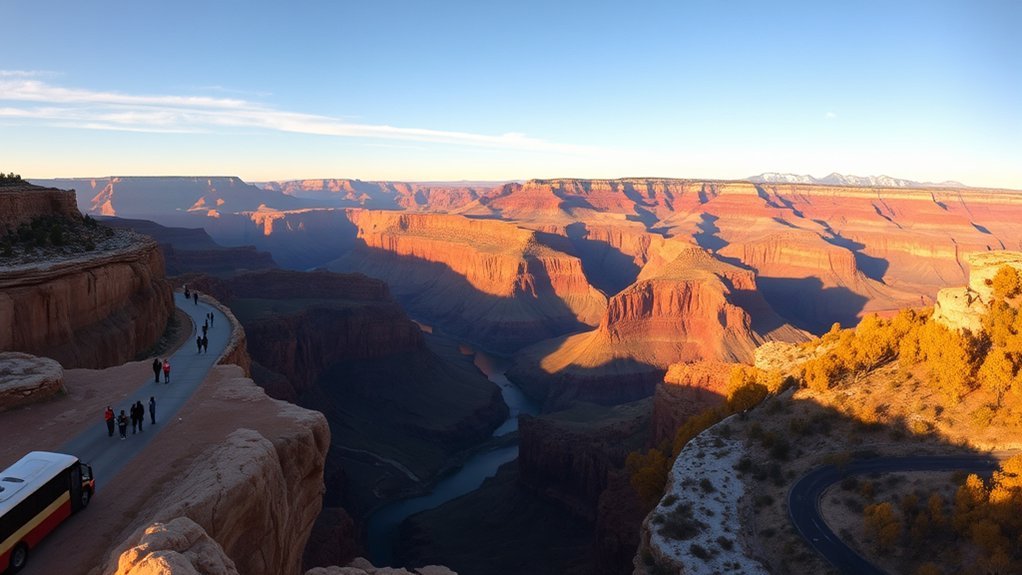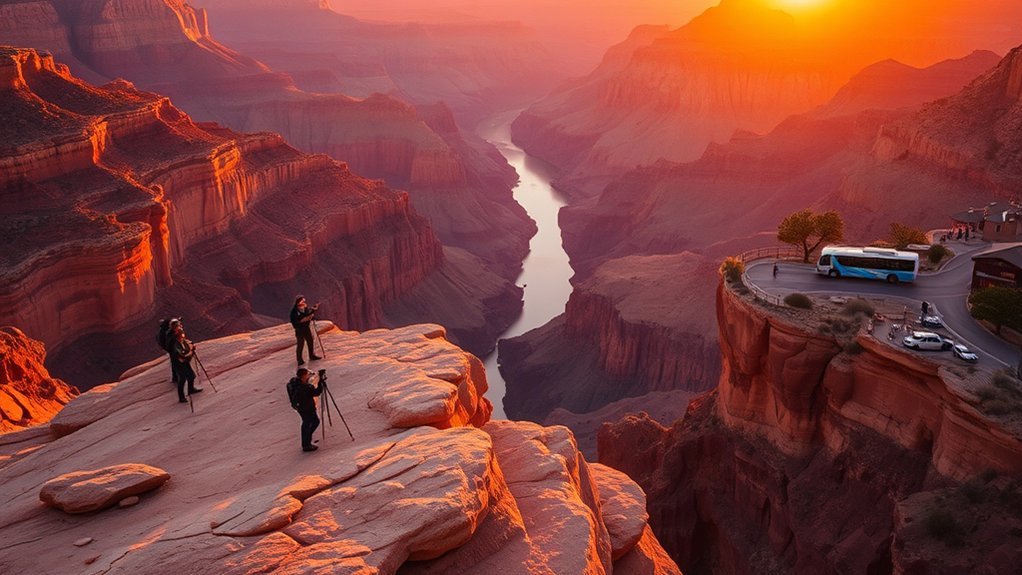If you’re planning a trip to the Grand Canyon’s South Rim, this guide helps you pick the best route, time of year, and must-see viewpoints so you get the most out of your visit. You’ll learn practical tips on airports and shuttles, when crowds and weather cooperate, and which overlooks, hikes, and tours are worth your time — plus where to stay — so you can plan confidently and avoid common pitfalls.
Getting to the South Rim: Routes, Airports & Transportation

Getting to the South Rim is straightforward whether you drive or fly: most visitors come by car along U.S. 180/64 from Flagstaff (about 80 miles, roughly 1.5 hours) or via I‑40 links from Phoenix (≈230 miles, 3.5–4 hours) or Las Vegas (≈270–290 miles, 4–4.5 hours). You can fly into Flagstaff Pulliam Airport if you want the shortest ground transfer, or choose larger hubs at Phoenix Sky Harbor or Las Vegas and rent a car. If you prefer not to drive, schedule a shuttle from Phoenix or Las Vegas into the region, then use local connections. Tusayan sits just outside the South Entrance with hotels, restaurants and seasonal park shuttle pickup to Grand Canyon Village, so it makes a convenient base. Once inside, rely on the free, year‑round shuttle system to reach overlooks, Visitor Center and Hermits Rest. For rim‑to‑rim travel, book private services like the Trans‑Canyon Shuttle, which runs scheduled transfers between South and North Rims.
Best Times to Visit: Weather, Crowds & Seasonal Tips

Timing your visit to the South Rim can make or break your experience, so pick the season that matches your priorities—crowds, temperatures, and activities. Peak season (June–August) brings the largest crowds and scorching inner-canyon heat—canyon floor temps often top 100°F—so book lodging and tours 9–12 months ahead. Shoulder seasons (March–May, Sept–Nov) offer milder hiking weather (spring ~50–70°F, fall ~50–75°F), fewer crowds, and better availability—ideal for day hikes and photography. Monsoon season in July–August delivers afternoon thunderstorms and lightning risk; plan morning hikes, check forecasts, and carry rain gear. Winter conditions (Dec–Feb) are quiet with possible rim snow, daytime highs in the 40s and very cold nights—bring microspikes and layered gear for icy trails. For classic sunrise sunset experiences, arrive early or stay a night to catch sunrise at Mather Point or Yaki Point and sunsets at Hopi, Yaki, or Mather Points when crowds are most manageable.
What to See and Do: Viewpoints, Tours, Hikes & Where to Stay

Now that you’ve picked the best time to visit, plan what you’ll actually do while you’re there—scenic viewpoints, hikes, tours, and lodging choices shape the whole Grand Canyon experience. Head to Mather Point, Hopi Point, Yavapai Observation Station and Desert View for classic panoramas and sunrise/sunset shots; each offers different light and composition. Use the South Rim shuttle (color‑coded routes) or a narrated 45‑mile driving tour to hit 20+ viewpoints without parking headaches. Hike from Grand Canyon Village on the Bright Angel Trail (water and rest houses at 1.5‑mile intervals to Indian Garden) or take the steeper South Kaibab Trail for shorter out‑and‑backs like Ooh Aah Point. Book guided tours for deeper interpretation—private hikes, Wildland Trekking multi‑day trips, or air tours by Papillon/Maverick and Grand Canyon Airlines. Stay inside the park at park lodges (El Tovar, Bright Angel, Yavapai, Maswik) for walkable rim access or in nearby Tusayan; reserve 6–12+ months ahead in peak season.
Frequently Asked Questions
How Much Time Is Needed for Grand Canyon South Rim?
You’ll need 2–3 hours for key overlooks, 4–6 hours for museums and a short below‑rim hike, a full day for longer hikes and multiple viewpoints, one night for sunrise/sunset, and 2–3 days to relax.
What Is the Best Time to Visit the South Rim of the Grand Canyon?
Think spring and fall—when the canyon breathes softer and light paints the rim. You’ll get milder temperatures, fewer crowds, ideal sunrise/sunset shots, and safer hiking; avoid summer heat for strenuous descents or peak-season crowding.
How Much Does It Cost to Go to the South Rim of the Grand Canyon?
Entrance fees start at $35 per private vehicle (or $30 motorcycle, $20 per person foot/bike). Annual park pass $70; America the Beautiful $80. Backcountry permits, lodging, campgrounds, and special activities add separate fees and reservations.
What Town Is Closest to the South Rim of the Grand Canyon?
Tusayan is the closest town to the South Rim, about 1.8 miles from the park gate; you’ll find hotels, restaurants, a grocery, and the Grand Canyon Airport, so you can stay conveniently near the entrance.
Conclusion
Plan your trip around shoulder seasons for milder weather and fewer crowds — the South Rim sees over 4.5 million visitors annually, so timing matters. You’ll likely fly into Flagstaff or drive from Phoenix/Las Vegas, stay in Tusayan if you want shuttle access, and use the free South Rim shuttle to reach Mather, Yavapai, Hopi and Desert View. Pack layered clothing, avoid midday summer heat, and bring microspikes in winter for safe, enjoyable viewpoints and hikes.

